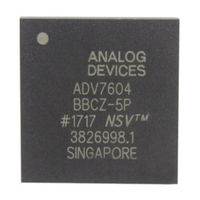User Manuals: Analog Devices ADV7604 Evaluation Board
Manuals and User Guides for Analog Devices ADV7604 Evaluation Board. We have 2 Analog Devices ADV7604 Evaluation Board manuals available for free PDF download: Hardware Manual, User Manual
Analog Devices ADV7604 Hardware Manual (409 pages)
Component/Graphics Digitizer with 4:1 Multiplexed HDMI Receiver
Brand: Analog Devices
|
Category: Computer Hardware
|
Size: 2 MB
Table of Contents
-
-
References11
-
Introduction13
-
Power Modes28
-
Pin Checker47
-
Llc Control57
-
Clamping65
-
Description74
-
Description88
-
Cable Detect90
-
Edid Ram99
-
External E-Edid106
-
Port Selection110
-
Tmds Measurement112
-
Video Fifo116
-
Pixel Repetition120
-
Hdcp Support121
-
Audio DPLL132
-
Audio FIFO133
-
MCLKOUT Setting138
-
DSD Interface141
-
HBR Interface143
-
Audio Muting144
-
Channel Status152
-
Category Code155
-
Word Length156
-
Packet Registers167
-
Repeater Support174
-
Status Registers184
-
Color Controls217
-
Background219
-
Datapath Summary219
-
Clamp and Gain220
-
Hsync Separation221
-
Clamp Operation227
-
Cp Offset Block241
-
Av Code Block242
-
Pregain Block245
-
Timing Controls284
-
Cp Hdmi Controls299
-
Free Run Mode300
-
Cp Status307
-
Clamp Control314
-
Framing Code336
-
Data Bytes337
-
Teletext343
-
CGMS and WSS344
-
Ccap345
-
Vitc346
-
Main Controls352
-
Clock358
-
Odule358
-
Main Controls363
-
Odule370
-
Clock370
-
Mode 1371
-
Mode 2371
-
Mode 3371
-
Mode Detection372
-
Interrupts374
-
Hardware Design382
-
Register Access383
-
Port383
-
DDC Ports385
-
DDC Port B386
-
DDC Port a386
-
DDC Port C387
-
DDC Port D387
-
Hdmi Inputs390
-
Digital Inputs391
-
Ordering Guide400
-
-
List of Figures401
-
List of Tables403
-
Advertisement
Analog Devices ADV7604 User Manual (27 pages)
Brand: Analog Devices
|
Category: Motherboard
|
Size: 1 MB
Table of Contents
-
6 Schematics
13 -
7 Layout
22

